A Halcyon Day in Elefsina, Revisited
Eating Well Is The Best Revenge
By Diana Farr Louis

“The site of The Mysteries, one of the holiest in the Ancient World, was not on any but the most scholarly tourist’s list of ‘must sees.’ Only an expert could make sense of the jumbled heaps of chopped columns and sculptural fragments, overlapping floors, and walls—relics of 2,000 years of building, rebuilding, and devastation—all dusted with fine cement.”—Diana Farr Louis
Editor’s Note: This essay was first published here in January 2013.
ATHENS Greece—(Weekly Hubris)—March 2018—We’d left our flat in the northern suburbs wearing three layers of woollies. The sun was shining through wispy clouds but looked as though it might have teeth, and we had been chilly inside since central heating has become a luxury reserved for when the mercury drops to 0.
Our destination? The ancient site of Eleusis, known to modern Greeks as Elefsina, for Sunday lunch.
Twenty years ago, such a proposition would have raised eyebrows in disbelief. Elefsina was an industrial horror, a no man’s land shrouded in smog from refineries, steel works, and cement plants that you smelled rather than saw as you drove by on the way to Corinth.
The site of The Mysteries, one of the holiest in the Ancient World, was not on any but the most scholarly tourist’s list of “must sees.” Only an expert could make sense of the jumbled heaps of chopped columns and sculptural fragments, overlapping floors, and walls—relics of 2,000 years of building, rebuilding, and devastation—all dusted with fine contemporary cement.
Given these parlous conditions, who could have predicted that Elefsina would reinvent itself? And yet, gone is the squalor and grime and, in their place, designer-pedestrianized streets lined with welcoming bars and eateries, green parks and squares, a cobbled waterfront with yachts instead of tankers on view, and restored neoclassical houses converted into cafés. Elefsina feels like a village, and a prosperous one at that.
As for the site, it is still a jumble, but a neater one now, well-signed and inviting, with an excellent small museum and stunning view of the bay of Salamis (despite the cement factory next door). Or perhaps because of it—the owners, Titan, turned out to have a conscience and helped orchestrate the clean-up.
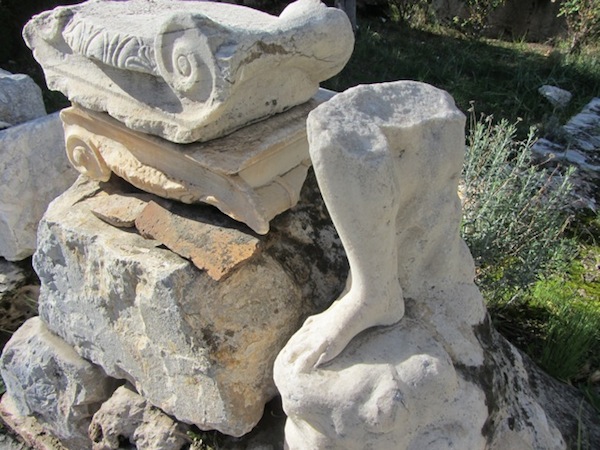
We met our friends at a shaded café opposite the main gate but did not sit for long, as sunlight beckoned. The man in the ticket booth won my heart. When I asked if there might be a special price for seniors, he said, “Yes, half price—2 euros—but you don’t look eligible.”
Later, when my spouse, Harilaos, “Joy of the People,” finished his ouzo and passed through, the dialogue took a different turn.
“Are you over 65?”
“Don’t I look it?”
“Here in Greece, you are what you say you are.”
“Indeed. Have you ever heard anyone say he’s a tax evader (forofygas)?”
At that, JotP said, the ticket seller nearly cracked up.
But the story didn’t reach us until we’d finished exploring and met up with Harilaos. Instead, we tried to remember what we knew about The Mysteries; fortunately one of the three of us had actually read the guide book. And in the now toothless sunshine, I shed the topmost of my garments—a parka bought years ago in Billings, Montana.
Large doses of imagination are a prerequisite for even a cursory flashback to Eleusis in its heyday—which began in the 15th century BC, but flourished from about 760 BC until the late 4th century AD. The gaping maw of a dark cave above the ceremonial hall easily brings Pluto to mind, but the hall itself is simply an immense stretch of floor. We tried to put a roof on it, squeeze 10,000 people inside, and turn off the lights. The pilgrims would have performed all sorts of preliminary rituals, which included bathing in the sea at Faliro along with piglets sacred to Demeter, processions, offerings, over a period of nine days, but whatever transpired within the hall on the seventh night was never leaked to the uninitiated.
Academics speculate that the refreshment on hand, a sacred drink of barley and mint, contained hallucinogens; that the night’s happenings and sound effects were engineered to manipulate the congregation’s fears, emotions, and beliefs in a powerful shared experience of death and rebirth. Execution faced anyone who breathed a word of it, but Cicero maintained, “The greatest gift of Athens to mankind and the holiest is the Eleusinian Mysteries.”
We ourselves puzzled over what might have transpired—a reenactment of Persephone’s kidnapping and return to earth?—but didn’t relish the idea of playing sardines in a blacked-out room with a horde of strangers and wondered about the plumbing. And yet I was wistful, envious of their trust and conviction. (It had to have been more transcendent that joining the Hajj or a mass wedding by Reverend Moon.) And the message was taken so seriously by fanatical early Christians that they reduced the site to rubble, obviously fearing that even the memory of revelations at Eleusis might contaminate their own view of the afterlife.
Heavy thoughts for such a mild sunny day, but a welcome distraction from our daily obsessions about pension cuts, unemployment, and unfair taxation. So we trudged and talked our way up the hill to the museum and its treasures, inside and out: a marble piglet, a Roman caryatid with a flower-pot head-dress and enviable earrings, vases, steles, statues . . . and that splendid view which, even marred by tramp steamers, dingy factories, and anonymous apartment buildings, still lifts the spirits.
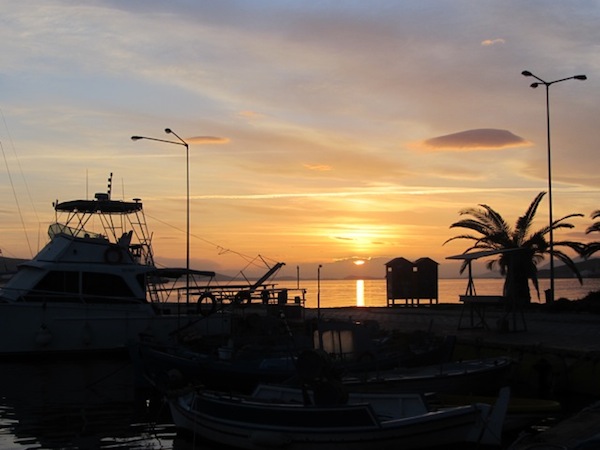
At this point, my husband appeared, we sat on a ledge in the sun for a few minutes, and then ambled down to the gates and out onto the brick-paved street down to the sea. This street means business: instead of signs showing people walking, there are bright yellow-and-orange barriers ingeniously installed to prevent any form of wheeled transport from violating pedestrians’ sacred space.
Several tavernes presented themselves along the way but we rejected them and pressed on towards the water, ignoring the rule that the quality of food invariably declines in direct proportion to the attractiveness of the location.
Today, though, we were in luck, and stumbled upon a taverna which turned out to be impeccable and affordable. Ears immediately outgrew stomachs as we listened to the waiter rattle off the menu, followed by our eyes as we chose the main course’s fish from the ice box. It was Sunday after all, and “I ftoheia thelei kalo perasei” (Poverty demands a treat). Everything, from the double portion of crisp whitebait, fava purée, boiled salad, fries, and grilled mourmoures (striped sea bream), which we hadn’t eaten since we stopped spear-fishing, proved delectable. The management even threw in a small plate of cherrystones, on the house, as well as chocolate-topped baklava coils.
We had all stripped down to our last layers, reveling in the typically Greek combination of good food, good company, and good weather, and remained nailed to our chairs until the sun had almost extinguished itself in the sea.
In the month for halcyon days, this one was extra special.
When I got home, reality barged in with an ugly message from the US government. Apparently, a local terrorist group had planted a bomb at The Mall, a few train stops away, set to go off at 11 a.m. US citizens were warned to watch out. What about Greeks!
Our visit to Elefsina put things in perspective. This is Greece after all, where violence and serenity, beauty and treachery have been coexisting since the beginning. We learn to live with it; can’t stop loving it. Doomed?
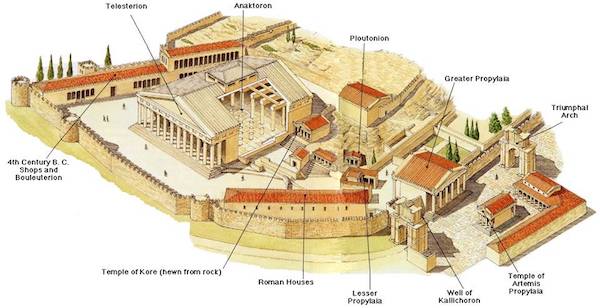

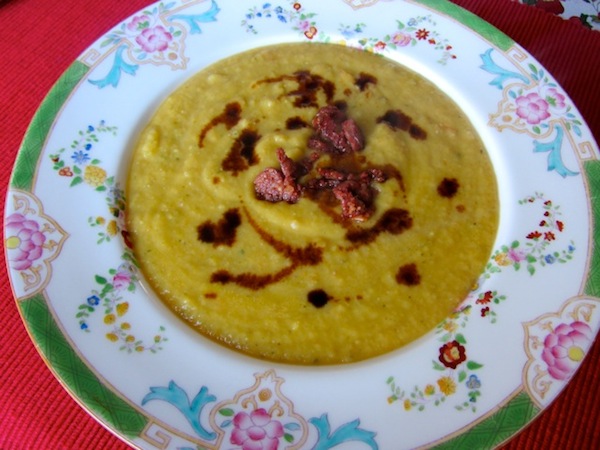
RECIPE
Fava/Split Yellow Pea Purée
This is a taverna standby. Regardless of the season, it’s a favorite appetizer, and couldn’t be simpler to prepare. But, if you can find fava—not to be confused with Italian broad beans but, rather, split yellow peas—from Santorini, snap them up. They will cost more, but the taste is a hundred times better than the ordinary supermarket brands. However, if you don’t find them/can’t afford them, the dish will still be a success. Fava purée should be served at room temperature, drizzled with fresh olive oil and lemon juice, sprinkled with finely sliced onions, and eaten with delicious country/hard-crusted bread.
Olive oil, 1/3-1/2 cup
1 medium red or other sweet onion, finely chopped
1 cup fava, rinsed and drained
5-7 cups water
Salt and pepper
Sliced sweet onions, for garnish
Capers and finely sliced sun-dried tomatoes, optional garnishes
Balsamic vinegar
Heat a few tablespoons of oil in a medium stew pot and sauté the onion until soft. Add the fava and stir to coat with oil. Pour in water to cover by about 2 inches, bring to a boil, and simmer for 1 ½ to 2 hours (Santorini fava take longer than ordinary brands) until they fall apart. Stir occasionally and add water if they absorb it all before they’re tender.
When the peas are soft, remove from the heat and let stand, covered with a cloth, for about an hour. They will become fairly solid and should be smooth but, if not, you can mash them with a fork, with a little more oil.
Season with salt and pepper, a hint of red pepper if you like, and the sliced onions. What will set this version apart from the taverna version is the addition of capers, sun-dried tomatoes, and a few drops of balsamic vinegar essence.
![]()
Editor’s Note: Halcyon Days: http://en.wiktionary.org/wiki/halcyon_days ; The Eleusian Mysteries: http://en.wikipedia.org/wiki/Eleusinian_Mysteries
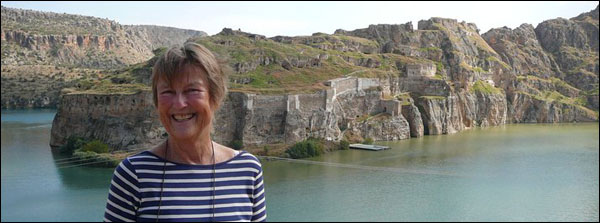


3 Comments
Di Drymoussis
As always – a joy to read. I can’t help feeling I need to go to Elefsina and see this reinvented version. I, like yourself, recall driving past, in years gone by, on our way to the village and holding my nose against the smells but now we just zip along on the Attiki Odos and turn off at the Elefsina exit but take a right towards Mandra instead of a left to Elefsina.
Sounds wonderful.
But Diana – your descriptions are ALWAYS wonderful.
di
xx
Alex Billinis
My Dear Diana, it is rare that I feel nostalgic for the days of my Greek repatriation. After reading this wonderful passage, I am full on pining for those days. Thank you.
Anita Sullivan
What a coincidence — I’m glued to the screen, reading another of your refreshing and warm-hearted essays, while in my kitchen a pot of yellow split peas is simmering in a vegetable broth I made a few days ago! What a great connection!
We are all connected by food and love and sacred mysteries! Thanks, Diana!